Conservatives continue to lead by 2 over Liberals as political opinion holds steady.
May 4, 2023
From April 28 to May 3, 2023, Abacus Data conducted a national survey of 1,750 adults exploring several topics related to Canadian politics and current events as part of our regular national omnibus surveys.
In this analysis, I update our regular tracking of opinions and attitudes toward Canadian politics with a specific focus on the Liberal Party as its policy convention is set to begin in Ottawa today.
Conservatives and Liberals remain statistically tied.
If an election was held at the time of the survey, the Conservatives would get 33% of the vote (unchanged from our last survey) the Liberals would get 31% (unchanged) and the NDP is in third at 19% (up 1). The BQ is at 7% nationally, the People’s Party at 5% and the Greens at 4%.

Regionally, the Conservatives have a slight lead in BC and a large lead in the Prairies. The Liberals and Conservatives are statistically tied in Ontario while the Liberals and BQ are statistically tied in Quebec. In Atlantic Canada, the Liberals have a 9-point lead over the Conservatives. All of these results are in line with your previous survey.

The Liberals are slightly ahead of the Conservatives among those under 30 while the Conservatives have a 10-point lead among those aged 45 to 59. The parties are statistically tied among those aged 30 to 44 and 60+.
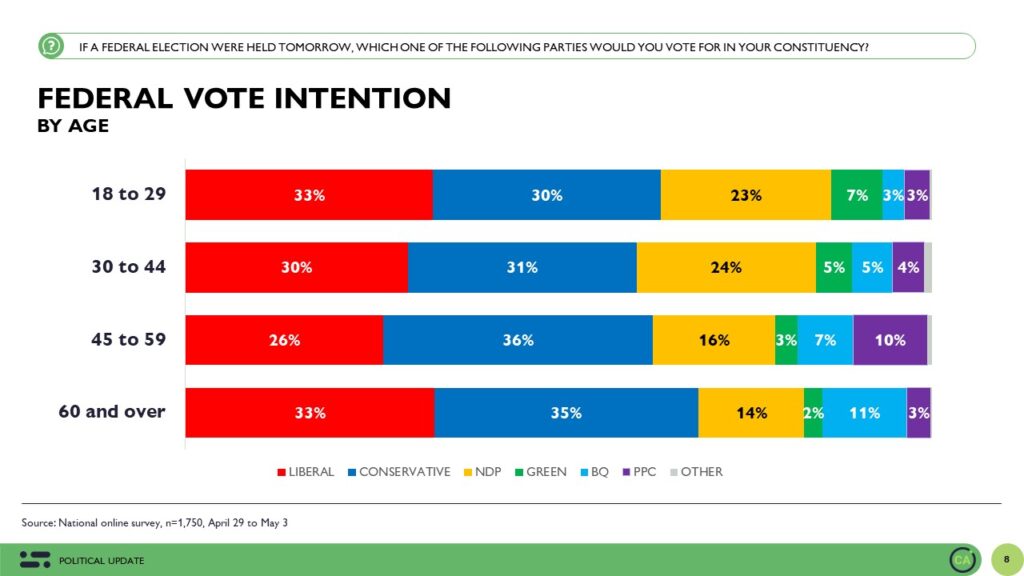
We find a large gender gap in vote intentions. The Conservatives lead by 9 among men while the Liberals are ahead by 4 among women. NDP support is 9 points higher (24%) among women than it is among men (15%).

As with vote intentions, other metrics are holding steady.
30% continue to believe the country is headed in the right direction, at or near the lowest point for several years.
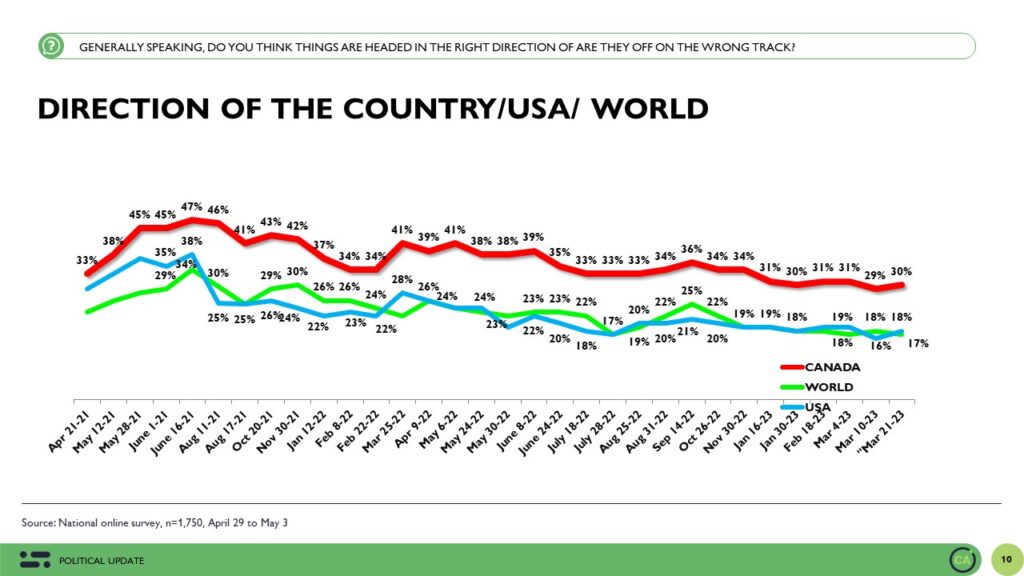
The federal government’s approval rating hasn’t changed much either. Today 34% approve while 49% disapprove, marginal changes from our last survey and consistent with what we have seen for several months now.

We also don’t see much shift in perceptions of the main party leaders.
Impressions of the party leaders are steady as well.
Justin Trudeau: 31% positive (+1) vs. 40% negative (+1) = -19 net
Pierre Poilievre: 31% positive (+2) vs. 35% negative (-1) = -4 net
Jagmeet Singh: 34% positive (-2) vs. 30% negative (NC) = +4 net



The Liberal Party’s Prospects
After almost eight years in office, the Liberal Party faces some significant hurdles in its quest for a fourth straight election victory. One way to understand its prospects is to examine its voter universe. Those who currently support the Liberals, don’t support them but are open to, and those who say they would not even consider voting Liberal.
Since the Liberals were first elected in October 2015, its accessible voter pool has shrunk substantially from a high of 70% soon after it was elected to 46% today. In fact, the Liberal accessible voter pool has hovered around the mid-40s now for about two years and has about the same sized accessible voter pool as the Conservatives.

Overall, 46% of Canadian adults say they are open to voting Liberal. 54% say they wouldn’t even consider voting Liberal. Of that 46% who are accessible, 25% would vote Liberal today and 21% wouldn’t vote Liberal but are open to doing so.

The first thing to note is that a majority government isn’t off the table for the Liberals. If the party was able to convert all of its accessible voters, then it could easily win a majority.
Looking at who and where these accessible voters are, we find that the party has substantial growth prospects in BC, Ontario, Quebec, and Atlantic Canada – regions that were critical to the party’s success in the past. Even 23% of Albertans who aren’t currently supporting the Liberals say they are open to voting Liberal. Theoretically, the Liberals could win close to 40% of the vote in Alberta.
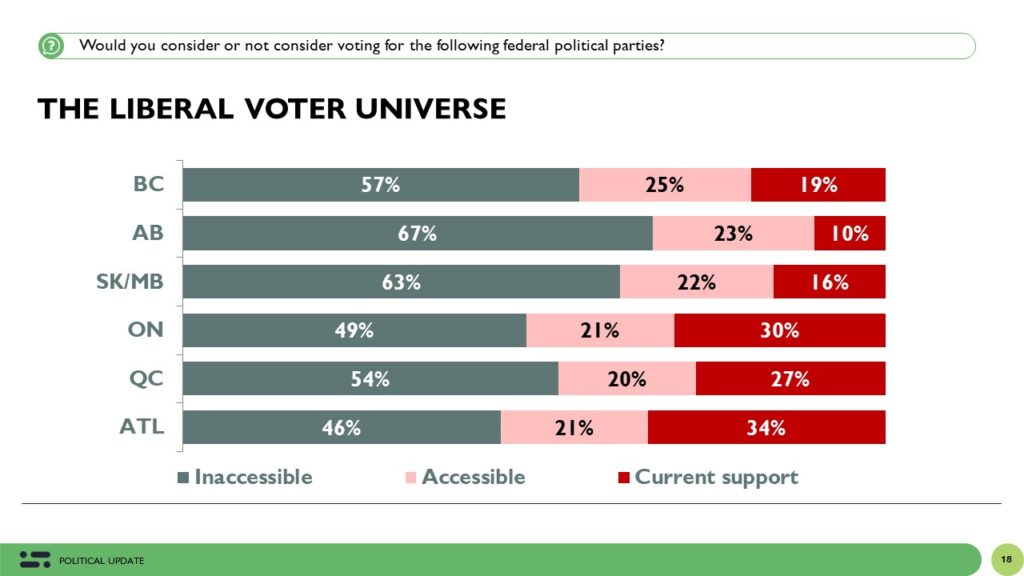
Demographically, the Liberals have better growth prospects with younger voters. Gen Z and Millennials have been critical to past Liberal victories, and they will be for any future ones. But the Liberals are struggling with those aged 45 to 59. They are the age cohort least accessible to the party today.
Understanding any crossover in voter universes also can help us understand where the competition for votes is.

Among accessible Liberals, 70% are also open to voting NDP, 48% are open to the Conservatives, and 53% are open to voting Green. Among current Liberals, the greatest risk is the NDP – where 1 in 2 supporters say they are open to voting NDP. Another 1 in 4 are open to voting Conservative or for the Greens.
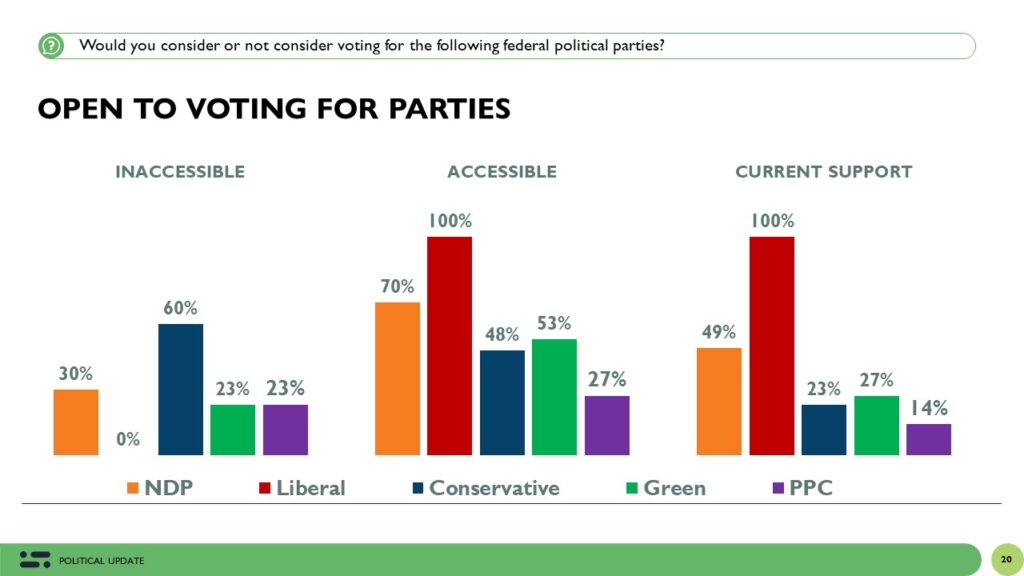
For the Liberals to grow support, they have to attract both undecided electors and those currently supporting other parties. Where’s the most promising ground? Well, 1 in 3 accessible Liberals would vote NDP right now. Another 1 in 5 say they would vote Conservative while 13% are voting for other smaller parties. 1 in 3 are undecided. This suggests that trying to squeeze NDP support remains the most viable path for the Liberals to increase its vote share – especially if the prospect of a Conservative government continues to become the perception of these voters.
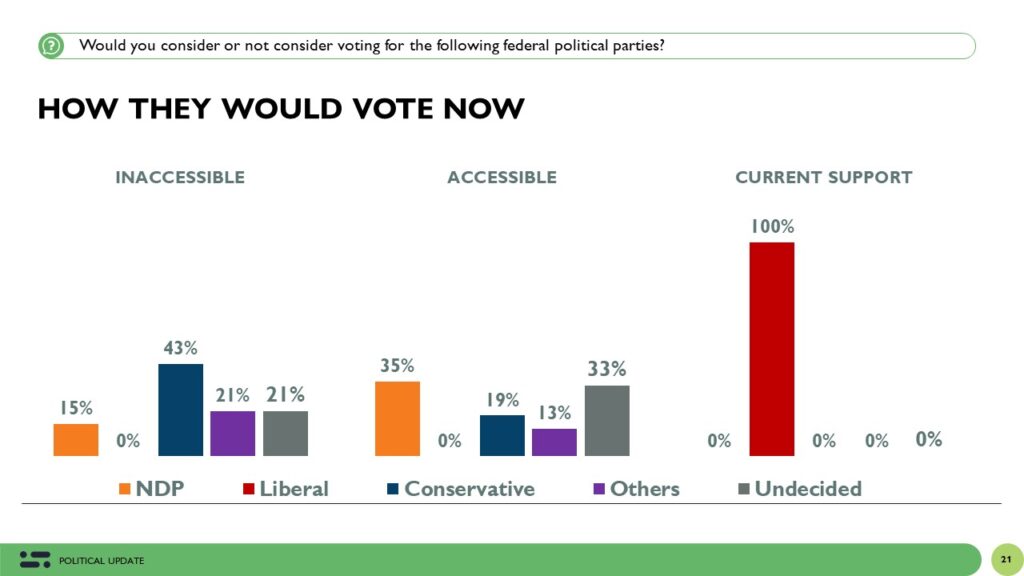
UPSHOT
According to David Coletto: “My reading of the Canadian political landscape hasn’t changed much in the past few weeks. The Conservatives have a small advantage but by all accounts, the political environment looks very much like it did at the end of the 2021 election. The only important difference remains that impressions of the Prime Minister, his government, and the direction of the country are all decidedly more negative than in the Fall of 2021.
In my view, what’s keeping the Liberals competitive are the Conservatives and Pierre Poilievre. They have not established themselves as acceptable alternatives to enough voters yet. That could change as those who don’t normally follow politics engage closer to an election. Alternatively, those who might otherwise vote Liberal may be less enthusiastic about that choice and simply decide to stay home. Both are viable paths for a Conservative win.
But at this stage, anyone who says the Liberals cannot win again aren’t paying close attention to the data. While the Liberal accessible voter pool is smaller than it was only a few years ago, it’s not too small. There’s still a path for another Liberal victory, even a majority one.”
METHODOLOGY
The survey was conducted with 1750 Canadian adults from April 28 to May 3, 2023. A random sample of panelists were invited to complete the survey from a set of partner panels based on the Lucid exchange platform. These partners are typically double opt-in survey panels, blended to manage out potential skews in the data from a single source.
The margin of error for a comparable probability-based random sample of the same size is +/- 2.4%, 19 times out of 20.
The data were weighted according to census data to ensure that the sample matched Canada’s population according to age, gender, educational attainment, and region. Totals may not add up to 100 due to rounding.
This survey was paid for by Abacus Data Inc.
Abacus Data follows the CRIC Public Opinion Research Standards and Disclosure Requirements that can be found here: https://canadianresearchinsightscouncil.ca/standards/
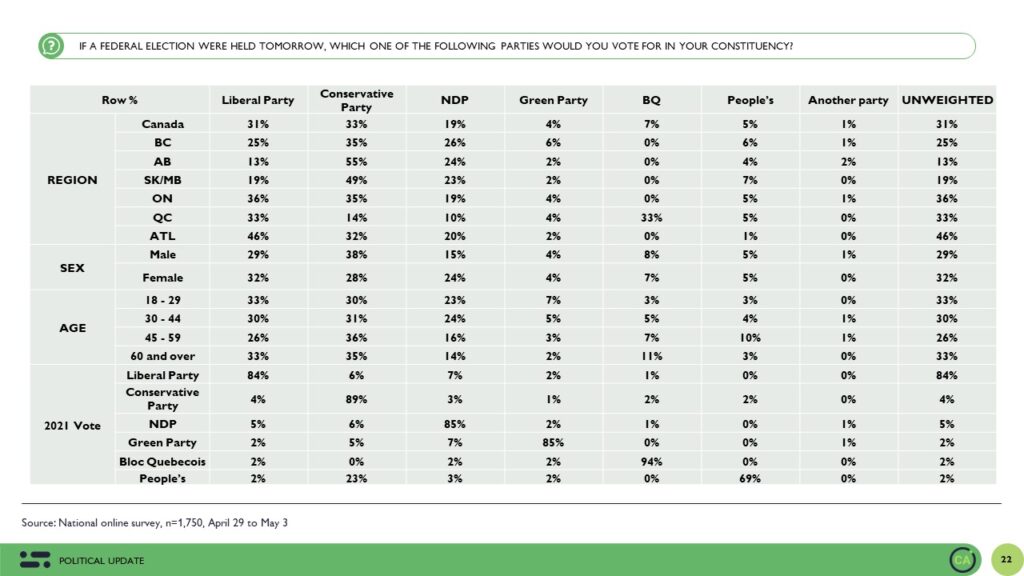
ABOUT ABACUS DATA
We are the only research and strategy firm that helps organizations respond to the disruptive risks and opportunities in a world where demographics and technology are changing more quickly than ever.
We are an innovative, fast-growing public opinion and marketing research consultancy. We use the latest technology, sound science, and deep experience to generate top-flight research-based advice to our clients. We offer global research capacity with a strong focus on customer service, attention to detail, and exceptional value.
We were one of the most accurate pollsters conducting research during the 2021 Canadian election following up on our outstanding record in 2019.
Contact us with any questions.
Find out more about how we can help your organization by downloading our corporate profile and service offering.



